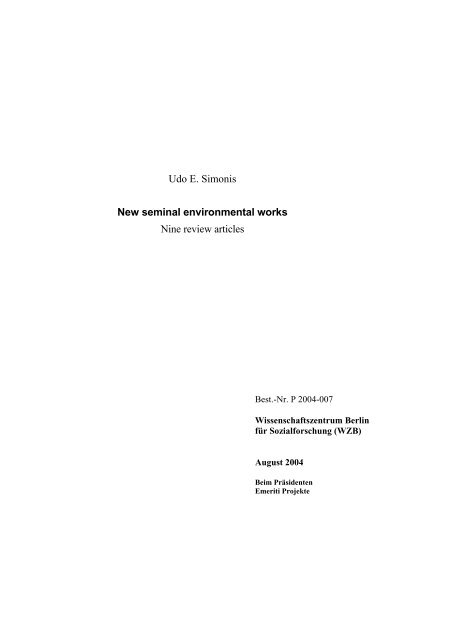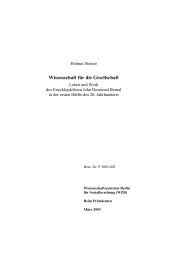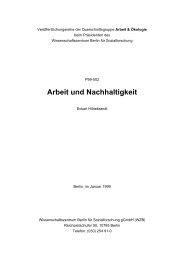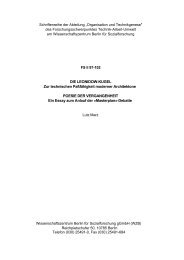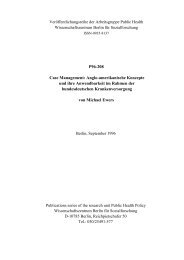New seminal environmental works. Nine review articles. - WZB
New seminal environmental works. Nine review articles. - WZB
New seminal environmental works. Nine review articles. - WZB
Create successful ePaper yourself
Turn your PDF publications into a flip-book with our unique Google optimized e-Paper software.
Udo E. Simonis<br />
<strong>New</strong> <strong>seminal</strong> <strong>environmental</strong> <strong>works</strong><br />
<strong>Nine</strong> <strong>review</strong> <strong>articles</strong><br />
Best.-Nr. P 2004-007<br />
Wissenschaftszentrum Berlin<br />
für Sozialforschung (<strong>WZB</strong>)<br />
August 2004<br />
Beim Präsidenten<br />
Emeriti Projekte
Contents<br />
1. Red Sky at Morning. America and the Crisis of the<br />
Global Environment……………………………………………… 3<br />
2. Green Giants? Environmental Policies of the<br />
United States and the European Union…………………………… 8<br />
3. Environmental Politics in Japan, Germany,<br />
and the United States……………………………………………… 8<br />
4. Natur und Macht. Eine Weltgeschichte der Umwelt……………… 14<br />
5. Mensch – Natur – Wissen. Grundlagen der Umweltbildung……… 19<br />
6. Our Common Journey. A Transition Toward Sustainability……… 23<br />
7. Institutionelle Reformen für eine Politik<br />
der Nachhaltigkeit………………………………………………… 27<br />
8. Turning Point. An End to the Growth Paradigm………………… 30<br />
9. Limits to Growth – The 30-Year Update………………………… 33
Udo E. Simonis 3<br />
Red Sky at Morning. America and the Crisis of the Global Environment<br />
By James Gustave Speth<br />
<strong>New</strong> Haven and London: Yale University Press, 2004, XV + 275 pp.<br />
ISBN 0-300-10232-1.<br />
“Red sky at night, sailors delight; red sky at morning, sailors take warning” –<br />
is a saying amongst sailors often borne out by experience. Gus Speth, the<br />
grand old man of American <strong>environmental</strong>ism, has written a shake-up book,<br />
a real danger signal. Actually, he is not that old, but old enough to get angry<br />
again. And angry Speth is about the failures to protect the global ecology,<br />
angry about the incompetence of the international community to prevent<br />
biological impoverishment – sad about the US administration whose<br />
priorities have strayed badly off the path. A little angry also on himself: ”My<br />
generation is a generation, I fear, of great talkers, overly fond of conferences.<br />
On action, however, we have fallen far short” (p. 8).<br />
In recent years, quite a few books and reports have been published on the<br />
state of the global environment, and on global <strong>environmental</strong> governance.<br />
None, I think, is like Speth’s book that combines qualities that seldom go<br />
together: extensive empirical evidence, razor-sharp analysis, and personal<br />
engagement, compassion even.<br />
The central hypothesis of the book is straightforward: It is about challeng-<br />
ing those who may believe that the international negotiations, treaties and<br />
other agreements of the past decades have prepared us to deal with global<br />
<strong>environmental</strong> threats; they haven’t: “The current system of international
4 <strong>New</strong> Seminal Environmental Works<br />
efforts to help the environment simply isn’t working. The design makes<br />
sure it won’t work, and the statistics keep getting worse. We need a new<br />
design, and to make that happen, civil society must take the helm” (p. xii).<br />
In four parts, Speth starts off to present such a new design by telling the<br />
story of how things got the way they are now – and how we can change<br />
them.<br />
Part I (pp. 11-73) is on how <strong>environmental</strong> challenges increasingly go<br />
global. He is presenting “A World of Wounds”, sweeping and disturbing<br />
evidence on the two mega trends of <strong>environmental</strong> degradation - industrial<br />
pollution and biological impoverishment - that occur in an increasingly<br />
fuller world. For such crucial issues as deforestation, loss of biodiversity,<br />
and climate change, he says, we have already run out of time. Speth is not<br />
quoting the Meadows at this point, but he makes it very clear: here, we are<br />
already beyond the limits. Instead, he is citing Dante’s notice at the en-<br />
trance of Hell: “Abandon all hope you who enter” (p. 11) and some of the<br />
statistics he is presenting are indeed hellish. Yet abandoning hope, he be-<br />
lieves, is precisely what we must not do: “However bad the situation looks,<br />
remember: there are solutions” (p. xiii) – better solutions than the ones dis-<br />
cussed and presented in the past.<br />
Thus, part II of the book (pp. 75–116) is a really fine <strong>review</strong> of the first at-<br />
tempts at global <strong>environmental</strong> governance. But no doubt, it is a <strong>review</strong> of<br />
an “Anatomy of Failure”. Given the magnitude of the challenges, the re-<br />
sponses mounted by the international community appear pitifully weak.<br />
Undoubtedly, international <strong>environmental</strong> affairs have become a major sub-<br />
ject of scholarly inquiry and teaching, a large body of relevant scholarship<br />
now exists – though only one <strong>environmental</strong> research was to win a Nobel<br />
prize so far (Rowland, Molina, Crutzen).
Udo E. Simonis 5<br />
It is interesting, Speth says, to contrast the <strong>environmental</strong> field with the<br />
economic one: The phrase “managing the global economy” comes easily;<br />
but “managing the global environment” still sounds strange somehow, fu-<br />
turistic even, although it should not: “The global environment is more of an<br />
integrated system than the global economy; it is even more fundamental to<br />
human well-being” (p. 78). The bottom line is that the treaties, agreements,<br />
and protocols do not drive the changes that are needed: “The Climate Con-<br />
vention is not protecting the climate, the Biodiversity Convention is not<br />
protecting biodiversity, the Desertification Convention is not preventing<br />
desertification, and even the older and stronger Convention on the Law of<br />
the Sea is not protecting fisheries”. In this manner, global <strong>environmental</strong><br />
problems have gone from bad to worse: “Governments are not yet prepared<br />
to deal with them, and, at present, many governments… lack the leadership<br />
to get prepared” (p. 97).<br />
Speth mainly blames his own country for the state of affairs: ”Following its<br />
leadership on ozone depletion, the United States has typically been the<br />
principal holdout on international <strong>environmental</strong> agreements” (p. 88). And,<br />
furthermore: “If there is one country that bears most responsibility for the<br />
lack of progress on international <strong>environmental</strong> issues, it is the United<br />
States” (p. 109).<br />
It is well known that the Bush administration has rejected the Kyoto Proto-<br />
col, but the list of important <strong>environmental</strong> agreements not ratified by the<br />
United States is much longer (see p. 110). Speth quotes political philoso-<br />
pher Benjamin Barber on the reasons for this: ”The policies can be traced<br />
directly to that proud disdain for the public realm that is common to all<br />
market fundamentalists, Republicans and Democrats alike... The United<br />
States fails to see that the international treaties it won’t sign, the criminal
6 <strong>New</strong> Seminal Environmental Works<br />
court it will not acknowledge, and the United Nations system it does not<br />
adequately support are all efforts… at developing a new global contract to<br />
contain the chaos... The ascendant market ideology claims to free us, but it<br />
actually robs us of the civic freedom by which we control the social conse-<br />
quences of our private choices” (p. 111).<br />
Part III of the book (pp. 117–147) is a major analysis of the underlying<br />
causes, the drivers of global <strong>environmental</strong> impacts, among them the well-<br />
known IPAT drivers: population, affluence and technology, and the forces<br />
loosed upon the world by the globalisation of the economy.<br />
In part IV (pp. 149–201), Speth presents his own solutions to the problems<br />
discussed. He calls his vision the “eight-fold way” – mega trends or transi-<br />
tions we need for global <strong>environmental</strong> protection and sustainable devel-<br />
opment (transitions 1 – 8): A stable or smaller world population; free of<br />
mass poverty; <strong>environmental</strong>ly benign technologies; <strong>environmental</strong>ly hon-<br />
est prices; sustainable consumption; ecological knowledge and learning;<br />
good governance; and active citizenry, a transition towards culture and<br />
honest <strong>environmental</strong> values.<br />
This, in my mind, is the major part of the book, a genuine contribution, of-<br />
fering many interesting and provoking ideas and suggestions – on FROG<br />
philosophy, GEOpolity, and taking JAZZ to scale, on transitions that need<br />
to be debated and must take place in local, national, and international insti-<br />
tutions to enable global <strong>environmental</strong> governance to succeed.<br />
This <strong>review</strong>er was especially pleased to find Gus Speth to be among the<br />
promoters of transforming the United Nations Environment Program<br />
(UNEP) into an effective World Environment Organisation (WEO): “Hav-<br />
ing a well-funded World Environment Organisation… would make a major<br />
difference” (p. 179), he says.
Udo E. Simonis 7<br />
There is an interesting and imaginative addendum to the book, a part V so<br />
to speak, the result of a collaboration with Kelly Levin and Heather Creech,<br />
entitled Resources for Citizens (pp. 203 – 228), and structured according to<br />
Speth’s “eight-fold way” (the eight major transitions). It is a documentation<br />
of US citizen actions (on organisations and Web-based resources) in areas<br />
where individuals have an impact on global <strong>environmental</strong> challenges, i.e.<br />
in their role as voters, investors, consumers, activists, and educators. (Read-<br />
ing this chapter on describing a multitude of citizen actions, readers will<br />
wonder how long the present US administration can further negate global<br />
<strong>environmental</strong> governance issues).<br />
The main message of the book in this way is further specified and becomes<br />
very concrete – while the author’s anger becomes more conciliatory: Major<br />
changes are in order, changes that must be driven by a sense of urgency.<br />
Effective global <strong>environmental</strong> governance needs a fair legal basis and<br />
strong institutions, but it would not succeed without higher <strong>environmental</strong><br />
consciousness and an active citizenry.<br />
Gus Speth’s book thus is alarming and visionary at the same time. It is an<br />
important and authoritative book on a looming global disaster – and on<br />
how to avoid it. If books can change the way we understand the future of<br />
our planet, this book will.<br />
To appear in: Environmental Values, Vol. 13, No. 3: a German version ap-<br />
peared in: Universitas. Orientierung in der Wissenswelt, Vol. 59, No. 3.
8 <strong>New</strong> Seminal Environmental Works<br />
Green Giants? Environmental Policies of the United States and the<br />
European Union<br />
By Norman J. Vig and Michael G. Faure (Eds.)<br />
Cambridge, Mass. and London: The MIT Press, 2004, XIII + 398 pp.<br />
ISBN 0-262-72044-2.<br />
Environmental Politics in Japan, Germany, and the United States<br />
By Miranda A. Schreurs<br />
Cambridge, UK: Cambridge University Press, 2002, XIII + 291 pp.<br />
ISBN 0-521-52537-3.<br />
Giants, they may be, the US and the EU, the US, Japan, and Germany, es-<br />
pecially in economic terms. But truly green they are certainly not yet, de-<br />
spite what is reported in these two books on <strong>environmental</strong> policies and<br />
politics. They are, no doubt, major players influencing the global environ-<br />
ment and the direction <strong>environmental</strong> protection has taken and will take in<br />
the future. Their ecological footprints are still large and their ecological<br />
rucksacks heavy.<br />
Actually, the volume edited by Vig and Faure is not about the greening of<br />
either the US or the EU, but compares major policy trends in these two<br />
parts of the world. The book by Schreurs could be seen that way too, but<br />
perhaps better as to how different the green colour shines when exposed to<br />
a thorough comparative study on internal <strong>environmental</strong> politics.
Udo E. Simonis 9<br />
Vig and Faure obviously were motivated by the fact that the relations be-<br />
tween the US and Europe (again) are at a low level, and that growing dif-<br />
ferences by the two sides over <strong>environmental</strong> policy may not only make<br />
transatlantic cooperation increasingly difficult but could seriously weaken<br />
the capacity of the international community to deal with a host of global<br />
<strong>environmental</strong> problems, the necessary priorities, and the methods of ad-<br />
dressing them. They believe there to be an urgent need for a new and stra-<br />
tegic dialogue between the US and the EU to discuss and strengthen com-<br />
mon interests in protecting the planet.<br />
The sixteen authors with different backgrounds from both continents were<br />
asked to test that hypothesis, clarify policy differences, and to specify the<br />
evidence for divergence across a range of <strong>environmental</strong> policy issues.<br />
Overall, the contributors present a mixed picture, and the editors worked<br />
hard to reconcile the problems and differences in their long concluding<br />
chapter.<br />
Although there is clearly a growing divergence over a number of interna-<br />
tional issues (especially climate change) and the principles and measures to<br />
address them, there appear to be numerous common trends in domestic<br />
regulatory practices, convergence even. One author, Jonathan B. Wiener,<br />
goes so far as to suggest that the widely held perception that the US and the<br />
EU have undergone a role reversal in <strong>environmental</strong> leadership is simply<br />
false: “Claims that US and European <strong>environmental</strong> policies are converging<br />
or diverging miss the more complex … reality” (p. 100). Instead, he sees a<br />
continuous process of balancing some risks against other risks, an interac-<br />
tion and mutual learning, the gradual evolution of standards and procedures<br />
on both sides – “hybridization”, as he calls it.
10 <strong>New</strong> Seminal Environmental Works<br />
Divergence, convergence, hybridization in the substance and objectives of<br />
<strong>environmental</strong> policies? I think every reader of this interesting and contro-<br />
versial book will have to make his own judgement. This, however, will not<br />
be easy as the cases presented differ in kind. As such, the volume is pre-<br />
senting differing perspectives on some fundamental questions rather than<br />
providing a definite set of firm conclusions.<br />
There are three chapters on general policy (particularly on the precaution-<br />
ary principle, and risk assessment), four on regulatory trends (particularly<br />
on federalism, negotiations, and liability), four on global issues (particu-<br />
larly on climate change, trade, and sustainable development), and two on<br />
trans-national net<strong>works</strong>. Although the chapters on general policy and regu-<br />
latory trends differ greatly, and some even contradict each other, those on<br />
global issues and on trans-national net<strong>works</strong> are more coherent. No doubt,<br />
however, the EU has become a leader, the US a laggard, as regards climate,<br />
biodiversity and water policies – all are fields, where multilateralism, bur-<br />
den sharing, and cooperation are needed, and where <strong>environmental</strong> protec-<br />
tion has to be seen as part of the protection of the common good.<br />
“It is the fundamental difference in attitudes … that is the most striking<br />
(and worrying) divergence between US and EU policies”, says Paul Harris<br />
(p. 271). “The incorporation of the precautionary principle and the goal of<br />
sustainable development into the EU Treaty in the 1990s implies a deeper<br />
philosophical commitment than any recent administration in the US has<br />
been willing to make”, the editors add (p. 353). And they conclude: “The<br />
EU’s strong support for normative principles, such as the precautionary<br />
principle, common but differentiated responsibility, and sustainable devel-<br />
opment to ensure international equity reflects a worldview quite different
Udo E. Simonis 11<br />
from the great power assumption that appears to govern Washington” (p.<br />
368).<br />
That picture, I think, would have become even more pronounced, if other<br />
issues had been investigated. For instance, chapters are missing on energy,<br />
chemicals, transport and other material flows where some progress towards<br />
ecological modernisation (de-carbonisation and de-materialisation) has<br />
been made but much still needs to be done. Development of a sustainable<br />
society requires major changes to socio-economic structures and decision-<br />
making institutions; it will require a shift to a new paradigm that incorpo-<br />
rates <strong>environmental</strong> concerns in a far more integral way than is currently<br />
the case in both the US and the EU.<br />
A more serious deficiency of Vig and Faure’s volume, however, may be<br />
that the understanding of <strong>environmental</strong> policy is mostly limited to the state<br />
and the supra-national level. Nearly nothing can be found on civil society,<br />
on <strong>environmental</strong> initiatives, and other (possible) stakeholders of the local<br />
Agenda 21 process. That’s a pity because many local communities, both in<br />
the US and the EU, have more progressive <strong>environmental</strong> strategies than do<br />
their national governments.<br />
For that reason, it’s good to take up and thoroughly study Miranda<br />
Schreurs’ book. The US, Japan, and Germany have been pursuing envi-<br />
ronmental protection with different levels of enthusiasm and with different<br />
tools. And so this book asks for the reasons in the differences in their envi-<br />
ronmental policy approaches, and finds answers in the respective develop-<br />
ment of quite different <strong>environmental</strong> communities and policy-making<br />
rules, in institutional structures and the opportunities and barriers they pre-<br />
sented to <strong>environmental</strong> actors in the three countries.
12 <strong>New</strong> Seminal Environmental Works<br />
Three specific questions are addressed in the book in a comprehensive and<br />
detailed manner. The first has to do with why <strong>environmental</strong> movements<br />
became institutionalised in such different ways: there is a strong Green<br />
Party in Germany, a pluralistic but divided community of <strong>environmental</strong><br />
NGOs in the US, and only a small and weak <strong>environmental</strong> community but<br />
strong and traditional bureaucracy in Japan. The second main question is in<br />
what ways differences in the make-up of <strong>environmental</strong> communities mat-<br />
ter for <strong>environmental</strong> policy change, different policy styles, actor arrange-<br />
ments and engagement as regards both domestic and global <strong>environmental</strong><br />
problems. The third main question is on changing perceptions and the na-<br />
tional readiness to learn from others. How do actors in a given system look<br />
at the outside world to find support for their ideas and capabilities?<br />
Japan learned much from the US, is very efficiency oriented and proceeds<br />
largely by seeking consensus. Germany took up lessons from her most pro-<br />
gressive European neighbours, and agreed to a loss of sovereignty to the<br />
EU. The US, instead, seems captured by big business, misread globalisa-<br />
tion as economic growth and free trade, and hasn’t cared much for multilat-<br />
eral solutions and events elsewhere in the Rio-plus process.<br />
There has been quite some change in Japan, Germany and the US in the<br />
relationships among state, industry, and society at large, and in the strate-<br />
gies and goals of societal actors in the <strong>environmental</strong> realm. The various<br />
chapters of Schreurs’ book are full of authoritative evidence of that. But<br />
these changes have been quite different in timing and substance and so,<br />
over time, altered politics and policies towards the present state of contro-<br />
versy.<br />
It is here, in the issues of differences, where the two books again coincide.<br />
All of the authors of Vig and Faure’s edited volume seem to agree that the
Udo E. Simonis 13<br />
EU of the 15, because of its constitutional structure and planned integra-<br />
tion, has been and is a learning institution that has become <strong>environmental</strong>ly<br />
conscious and embraced enriched <strong>environmental</strong> policy-making. The EU<br />
took the <strong>environmental</strong> challenge as a stimulus to innovation, and that<br />
hopefully will continue in the EU of the 25. There are reasons enough for<br />
new and substantive dialogues on greening society, on sustainable devel-<br />
opment strategies, on reducing the ecological footprint and on lightening<br />
the ecological rucksack. There is further and pressing need for such dia-<br />
logues, not only between the US and the EU, the US, Japan, and Germany,<br />
but for all the world’s nations, or at least the most willing. Both books<br />
show how such dialogues could be organised and what they should focus<br />
on.<br />
To appear in: The Environmentalist, Vol. 24, No. 4.
14 <strong>New</strong> Seminal Environmental Works<br />
Natur und Macht. Eine Weltgeschichte der Umwelt<br />
[ Nature and Power. A World History of the Environment ]<br />
By Joachim Radkau<br />
München: C.H. Beck Verlag, 2002, 438 pp.<br />
ISBN 3-406-48655-X.<br />
A fine book, a significant book, but also a confusing one! Fine, because it<br />
provides a good example of the art of printing at its best and is written in a<br />
readable language. It is also a significant book, one of the author's main<br />
books on an important topic; a book that absolutely had to be written. But<br />
where is the best starting point - the Phoenicians, England's industrialisa-<br />
tion, or perhaps the rise of the concept of "environment"? And how best<br />
structure the great profusion of potential material - with an eye to cultural<br />
history, geography, the <strong>environmental</strong> media, in terms of problems of wa-<br />
ter, air, and soil?<br />
Somehow the author has managed to get it done, in 340 pages of text, in 83<br />
pages of references, and a 16-page index. But what about his working hy-<br />
pothesis? In view of all the things that go into the making of a world his-<br />
tory of the environment (thus the book's subtitle), or could be said on the<br />
subject of nature and power (the book's main title), the reader might think,<br />
it should be possible to know what is important and what is less important.<br />
A theory would be needed - for without theory everything is, as the saying<br />
goes, one-off - or at least a reasoned explanation of what distinguishes (and<br />
to what extent) <strong>environmental</strong> history from history, world <strong>environmental</strong><br />
history from world history. If we are to discuss the issue of nature and
Udo E. Simonis 15<br />
power, it would be important to state not only what nature is but what<br />
power is, too. The author fails to deliver a positive definition of these con-<br />
cepts - a theory - though he is by no means short on explanations of what<br />
his book is not concerned with.<br />
Radkau pointedly disavows Toynbee's history of high civilization, and<br />
Braudel's history of the Mediterranean basin - not only but mainly for their<br />
lack of ecological considerations. But even time-conscious <strong>environmental</strong><br />
history, he notes, is not without it blinkers; instead of focusing on agrarian<br />
and forest history, long distance migrations, or the great epidemics, the lat-<br />
ter is for the most part concerned only with industrial water and air pollu-<br />
tion or - as the author says - with nothing but the history of ideas of nature.<br />
We here find an inkling of what the author is intent on proving. He formu-<br />
lates it as follows: "In reality, <strong>environmental</strong> history does not merge into a<br />
history of <strong>environmental</strong> policy, i.e. into a history purposefully made by<br />
man; it instead remains in essence a history of the unplanned and unex-<br />
pected, of the persistently unstable symbiosis between man and nature" (p.<br />
339).<br />
So Radkau does not want to enter history as a crisis historian. Most of the<br />
universal leitmotifs of <strong>environmental</strong> history - the author notes - are keyed<br />
to crisis. Environmental history, however, is - he goes on - not only the his-<br />
tory of the fall and its never-ending aftermath, it is not only the story of<br />
humans and the <strong>works</strong> of men, it is also the story of sheep and camels, of<br />
swamps and barrens (p. 15).<br />
Thus attuned, the author takes us on a long journey back to the Middle<br />
Ages and the early epochs of history (as regards the climate problem, even<br />
back to the Ice Age), to all continents, a good number of regions, to many<br />
peoples and cultures - to many where we would expect to find a symbiosis<br />
between man and nature, to Buddhism and the indigenous populations of
16 <strong>New</strong> Seminal Environmental Works<br />
Australia and America, though not to certain others - not to the Amish, not<br />
to the Amhar, and not to the Eskimos either.<br />
"Thinking about Environmental History," is the title of the book's first<br />
chapter; the second, dealing with the history of fire ecology and of man as<br />
hunter, gardener, and herdsman, is called: "In the Beginning was Fire."<br />
Symbiosis aplenty, had not then the "tragedy of the commons" appeared on<br />
the scene. The author takes a hard look at Garret Hardin's famed article of<br />
1968 on the demise of the commons as the prototype of a dynamic ecologi-<br />
cal decline, though it should be noted that what Hardin had in mind was the<br />
global commons, particularly climate, biodiversity, and the oceans.<br />
This is followed by an interesting section on the ecology of religion, called<br />
"Mother Earth and Father in Heaven." The significant <strong>environmental</strong> im-<br />
pacts of the world religions, the author states, are to be sought below the<br />
level of metaphysics, in trivial areas - monasticism, the rejection by the<br />
Catholic Church of contraceptives, the suppression of an important reason<br />
for forest protection in the form of the Judeo-Islamic disdain for pork, and<br />
the taboo on human excrements in Islamic and Hindu regions.<br />
The third chapter of the book comes closest to keeping the promise held out<br />
by its title; it’s on the history of "Water, Forests, and Power." It is here that<br />
the environment first came upon the scene as a common in need of protec-<br />
tion against private self-interest. Hydraulic engineering, power relations,<br />
and ecological chain reactions are the one thread, formulated with an eye to<br />
the examples of Egypt and Mesopotamia, the terrace cultures of Indonesia<br />
and China, the canal cultures of Venice and Holland; the other thread, de-<br />
forestation, forest clearance, and forest regimes, is exemplified with refer-<br />
ence to Europe. Here many an author of renown is reinterpreted in the light<br />
of ecology and <strong>environmental</strong> policy: Geertz, Wittfogel, Needham, Huiz-
Udo E. Simonis 17<br />
inga, and, who else, Goethe (on the lack of cleanliness among the Vene-<br />
tians).<br />
Radkau dedicates one chapter to colonialism, in its trade- and settlement-<br />
related manifestations. The empirical examples range from the Mongol<br />
empire and the colonial history of India to the ruthless exploitation of for-<br />
ests, wildlife, and soils in North America. Highly interesting the last sec-<br />
tion of this chapter, dealing with repercussions of colonialism on the colo-<br />
nial powers themselves. In England, John Evelyn drew up the 17th cen-<br />
tury's most famous appeal for reforestation; guano imports from Peru,<br />
which got underway around 1840, not only eliminated the fertilizer deficit<br />
facing English agriculture, it was also this development that made possible<br />
the general introduction of the water closet.<br />
The author has provided Chapters 5 and 6 with a motto that makes them<br />
absorbing reading, while at the same time casting them in a more indeter-<br />
minate hue: "It is not the illusion of final knowledge but a receptivity for<br />
the flow of things and unexpected experiences that we will find at the end<br />
of <strong>environmental</strong> history" (p. 51). More than all else, the forests have be-<br />
come the embodiment of ecological conservation interests vis-à-vis the<br />
great variety of destructive political interests that have accompanied indus-<br />
trialisation. Citing a profusion of examples and presenting meticulous in-<br />
detail views, Radkau looks into the interests informing "the protection of<br />
nature and local traditions [Heimat]" in Germany, as well as the ideas sur-<br />
rounding a "national nature" in the U.S. In Germany, there was no Rachel<br />
Carson, and yet the <strong>environmental</strong> movement had its heyday here. This<br />
aspect holds a particular fascination for the historian - and so for others,<br />
these passages may be a bit on the long side.<br />
The book ends on a prognostic note which the attentive reader might like-<br />
wise be inclined to question: "Because there is absolutely no prospect of
18 <strong>New</strong> Seminal Environmental Works<br />
any effective global regulation of the relations between man and the envi-<br />
ronment, and politics and its institutions are limited in their ability to deal<br />
effectively with the complexity and variability of <strong>environmental</strong> problems,<br />
mankind will, as always in its history, continue in essence to be reliant on<br />
nature's self-healing powers" (p. 339). First of all, the author is contradict-<br />
ing himself here, as he has cited numerous examples to prove that it has<br />
indeed been possible to successfully regulate the relations between man<br />
and his environment - now and then. And on the other hand, one could<br />
have looked more carefully into those self-healing powers of nature. Nature<br />
itself may indeed possess constructive power as a living being, this at least<br />
is the proposition of the Gaia hypothesis. But Joachim Radkau, the author<br />
of "Nature and Power," fails, in spite of the occasional quote, to take a sub-<br />
stantive note of the author on the natural power of nature, James Lovelock.<br />
Reason enough for another book – perhaps in English?<br />
Appeared in: Environmental Values, Vol. 10, No. 2; a German version ap-<br />
peared in: Zeitschrift für Umweltpolitik und Umweltrecht, Vol. 23, No. 2.
Udo E. Simonis 19<br />
Mensch – Natur – Wissen. Grundlagen der Umweltbildung<br />
[ Humans – Nature – Knowledge. Foundations of Environmental<br />
Education ]<br />
By Malte Faber and Reiner Manstetten<br />
Göttingen: Vandenhoeck & Ruprecht, 2003, 240 pp.<br />
ISBN 3-525-30141-3.<br />
„Wenn man sich aber vorstellte, welchen Standpunkt die Natur im Sinne<br />
der Gesamtheit alles Lebendigen einnehmen würde, so müsste man bei<br />
Eingriffen von Menschen (in die Natur) nicht nur fragen: Was bedeuten sie<br />
für den Menschen? Sondern auch: Was bedeuten sie für andere Lebewesen<br />
und für das Leben überhaupt?“ (S. 42).<br />
Das Gemeinschaftswerk eines Philosophen und eines Ökonomen, das diese<br />
Grundsatzfrage behandelt, lässt sich nicht nur an den üblichen Kriterien<br />
messen, die man an wissenschaftliche Bücher anzulegen pflegt: ob sie denn<br />
theoretisch interessant, empirisch relevant und zeitlich aktuell seien. Dieses<br />
Buch ist neben alledem auch radikal. Es handelt sich um Vorlesungen zur<br />
Komplexität des Verhältnisses von Mensch und Natur und es bezweckt ei-<br />
ne Radikalisierung unseres Denkens darüber: „Die Sache, um die es geht,<br />
ist die Grundlegung einer Umweltbildung…, deren Anliegen (es ist), die<br />
Fähigkeit der Menschen zur Selbstwahrnehmung, Weltkenntnis und Natur-<br />
begegnung zu fördern, ...was die selbstkritische Reflexion ungeprüfter Ü-<br />
berzeugungen, vorgefasster Meinungen und eingefahrener Handlungsmus-<br />
ter voraussetzt“ (S. 9).
20 <strong>New</strong> Seminal Environmental Works<br />
Der ungeprüften Überzeugungen, vorgefassten Meinungen und eingefahre-<br />
nen Handlungsmuster gibt es ganz sicherlich viele. Und so finden die Auto-<br />
ren in einer Art virtuellen Gesprächs mit dem Leser/der Leserin viele Gele-<br />
genheiten, radikale Fragen zu stellen und übliche, alt gewohnte Antworten<br />
über Bord zu werfen.<br />
Dies traut man am ehestens wohl einem Naturwissenschaftler und – was<br />
das Verhältnis von Mensch und Natur angeht – einem Ökologen zu. Hier<br />
aber haben sich ein Philosoph und ein Ökonom zusammen getan, denen es<br />
um die zukunftsfähige Weiterentwicklung unserer Gesellschaft geht, worin<br />
der außer-, der mit-menschlichen Natur ein ihr gebührender Platz einge-<br />
räumt wird. Dazu bedarf es einer konsequenteren Sichtweise auf das<br />
Mensch-Natur-Verhältnis; Wissen verschiedener Gebiete müssen in einer<br />
gemeinsamen Begrifflichkeit gefasst und in einen gedanklichen Zusam-<br />
menhang gestellt werden.<br />
Diesen eigenen Anspruch versuchen die Autoren in zwölf Kapiteln einzu-<br />
lösen, einem ersten über die Bedeutung des Begriffs Umwelt, einem zwei-<br />
ten Kapitel über die zentralen Fragen und Aufgaben der Umweltbildung.<br />
Den beiden Wissenschaften mit dem gleichen griechischen Wortstamm -<br />
der Ökologie und der Ökonomie - gilt ein eigenes, das 3. Kapitel.<br />
In den Kapiteln 4 bis 6 untersuchen die Autoren die Grundlagen des<br />
menschlichen Wissens, den „Wissenschaftslogos“, den „Wesenslogos“ und<br />
den „Daseinslogos“. Wie die Formen des Wissens zum Verhältnis von<br />
Mensch und Natur ineinander greifen, wird im 7. Kapitel anhand von Be-<br />
trachtungen zur utopischen Vision Francis Bacon’s und zu Goethes Faust<br />
dargestellt.
Udo E. Simonis 21<br />
In den Kapiteln 8 und 10 geht es um die philosophischen Grundlagen einer<br />
neuen Sicht auf ökologische Fragen, wobei die gängigen Vorstellungen von<br />
Selbsterhaltung und Reproduktion ergänzt werden um das Konzept der<br />
Dienste (oder Fonds), die Menschen für andere Lebewesen und Ökosyste-<br />
me leisten. In den abschließenden Kapiteln 11 und 12 geht es den Autoren<br />
um das, was sie die Grundlegung einer „menschlichen Wirtschaft“ nennen:<br />
Das individuelle Eigeninteresse, das die wirtschaftswissenschaftlichen<br />
Standardmodelle als hauptsächliche Orientierung des Menschen unterstel-<br />
len, wird ergänzt, müsse ergänzt werden durch das Interesse an Gemein-<br />
schaft und das Interesse am Ganzen der Welt…<br />
Umweltbildung heißt - so ließe sich nach Lektüre dieses Buch definitorisch<br />
festhalten - einerseits den Menschen in seiner Selbstwahrnehmung, seiner<br />
Welterkenntnis und seiner Naturbegegnung zu betrachten und zu verstehen,<br />
andererseits nicht weniger die Natur zu betrachten und zu respektieren, als<br />
Zusammenhang allen Lebendigen. Umweltbildung weiter zu befördern<br />
hieße, Zugänge zu diesen Ganzheiten zu finden, anthropozentrische und<br />
biozentrische Sichtweisen zu akzeptieren und sie zu integrieren.<br />
In den Metaphern des letzten Kapitels ausgedrückt: Es gilt zu erkennen,<br />
dass es nicht nur, wie der derzeitige gesellschaftliche Grundkonsens und<br />
die herrschende Ökonomie es suggerieren, auf das Eigeninteresse, den ho-<br />
mo oeconomicus ankommt. Es gibt auch das Interesse an der Gruppe, an<br />
Gemeinschaft, den homo socialis. Und es gibt schließlich, wenn auch viel-<br />
leicht nur schwach ausgeprägt, Interessen, die sich auf die Welt als Ganzes<br />
beziehen, den homo globalis.<br />
Welche Interessen unter welchen Bedingungen - räumlich wie zeitlich -<br />
überwiegen, das grundsätzlich mögliche Gleichgewicht im Verhältnis zwi-<br />
schen Mensch und Natur stören, und so zu schwerwiegenden oder irrever-
22 <strong>New</strong> Seminal Environmental Works<br />
siblen Umweltschäden führen, diese Frage bleibt auch in diesem tief schür-<br />
fenden Buch eher offen. Weitergehende Interessenharmonisierung, der ho-<br />
mo sustinens, bleibt als Aufgabe – für Philosophen wie Ökonomen, für die<br />
Leser wie die Nicht-Leser.<br />
Appeared in: Universitas. Orientierung in der Wissenswelt, Vol. 59, No. 4.
Udo E. Simonis 23<br />
Our Common Journey. A Transition Toward Sustainability<br />
By the Board on Sustainable Development<br />
Washington, D.C.: National Academy Press, 1999, 363 pp.<br />
ISBN 0-309-06783-9.<br />
In the Netherlands, in Denmark, and elsewhere in Europe there have been<br />
interesting discussion forums focusing on the subject of sustainable<br />
development. We can now also report on an attempt from the United<br />
States.<br />
A report moderate in length though far-reaching in its intent has appeared<br />
there under the title: Our Common Journey. The title quite consciously<br />
plays on the title of the epoch-making 1987 report of the World<br />
Commission on Environment and Development (Our Common Future),<br />
seeking in some lengthy passages to pick up again on, and to answer, the<br />
questions at that time formulated as fundamental.<br />
The effort and commitment involved in this new report must have been<br />
enormous: the 25 members of the Board on Sustainable Development at the<br />
National Research Council (NRC), and scientists from various disciplines,<br />
discussed four years long how we - the Americans and the global citizens -<br />
can be steered on to a path of sustainable development.<br />
This effort entailed evaluating some 375 NRC reports and hundreds of<br />
other sources, as well as holding various <strong>works</strong>hops and symposia. Now,<br />
the final report is available in book form. Occasion enough for a broader,<br />
worldwide discussion.
24 <strong>New</strong> Seminal Environmental Works<br />
The report claims to be reinvigorating the strategic relations between<br />
scientific research, technical development, and long-term social interests.<br />
An attempt is made to forge links between critical ecological challenges<br />
with economic and social potentials. Three terms play a central role here:<br />
transition to sustainability, journey, and navigation. Sustainability is,<br />
accordingly, not an end product but a process; many, all of us, must set out<br />
on the journey; and here we have to rely on a good, reliable navigation<br />
capacity.<br />
The Board is of the opinion (first part of the report) that the primary goals<br />
of the transition to sustainability should be to satisfy the basic needs of the<br />
growing future world population, by then far more (twice as?) numerous<br />
than at present; to safeguard the planet's life-support systems; and to<br />
overcome hunger and poverty. There are powerful counterintuitive trends<br />
working against these (high) objectives: urbanization, wealth disparities,<br />
wasteful consumption, power shifts in the wake of the growing<br />
globalisation of the economy. Yet, even the most alarming of trends - the<br />
Board says - can experience transition - a forceful, albeit naive, section of<br />
the report.<br />
Comprehensive, then, the future scenarios presented (second part of the<br />
report), in which the Board focuses on three instruments: integrated<br />
evaluation models, scenario techniques, and regional information systems<br />
for use in achieving the required advances in fundamental knowledge and<br />
social and technological capacities. All that will be lacking, then, is the<br />
political will - and it (typically American?) is simply presupposed:<br />
sustainability, it is claimed, can be achieved within two generations (that is,<br />
by the year 2050 or so).
Udo E. Simonis 25<br />
A good part of the argumentation is devoted to <strong>environmental</strong> risks, with<br />
<strong>environmental</strong> reporting experiencing a positive reassessment: It is - the<br />
authors argue - necessary to come to a rapid consensus on indicators of<br />
success or failure, above all because they are at present no yet available, at<br />
least not in consensual form. Indicators on global, planetary systems, on<br />
regional and sectoral vulnerability, and on local stocks of robust systems<br />
are set out here as necessary categories.<br />
If, and to the extent that, we must aim for sustainability by means of trial<br />
and error, through social experimentation, we find ourselves in need of<br />
strategies and institutions that link imperfect knowledge, flexible<br />
management, and social learning.<br />
The highlights of the report's most absorbing chapter in keywords:<br />
developing a science of sustainability; preparing for emergency action;<br />
doubling and multiplying material and energy efficiency; advancing<br />
regional and local implementation strategies...<br />
Conducted in Europe, a sustainability discourse would be likely to include<br />
more concrete categories of steps and targets: reduction, phase-out, phase-<br />
in, for instance. And it would tend more to be an analysis of constraints<br />
than options. That, after all, distinguishes Europeans from Americans.<br />
But Americans are also aware of their responsibility: “There is no<br />
precedent for the ambitious enterprise of mobilising science and technology<br />
to ensure a transition to sustainability. Nevertheless, the United States has a<br />
special obligation to join and help guide the journey” (p. 14). Exactly so, as<br />
the U.S. not only has a robust, powerful, scientific and technical capacity, it<br />
is also one of the greatest consumers of scarce global resources.<br />
Sustainably organised communities exist, but local AGENDA 21 processes
26 <strong>New</strong> Seminal Environmental Works<br />
are still a rare phenomenon in the U.S. So, modesty where it is appropriate,<br />
resolution where it is called for.<br />
A readable, a stimulating, visionary report on our - as the title rightly puts<br />
it - common journey to sustainability.<br />
Appeared in: International Journal of Social Economics, Vol. 29, No. 4;<br />
reprinted in: Environmental Values, Vol. 11, No. 2.
Udo E. Simonis 27<br />
Institutionelle Reformen für eine Politik der Nachhaltigkeit<br />
[ Institutional Reform for a Policy of Sustainability ]<br />
By Jürg Minsch, Peter-Henning Feindt, Hans-Peter Meister, Uwe Schnei-<br />
dewind, and Tobias Schulz<br />
In collaboration with Marc Mogalle, Jochen Tscheulin, Claus Wepler, Jür-<br />
gen Wüst, and Rold Wüstenhagen<br />
Berlin and Heidelberg: Springer, 1998, XIX + 445 pp.<br />
ISBN 3-540-64592-6.<br />
Following years of laborious discussion on what long-term environmen-<br />
tally sound or (better!) sustainable development really is, five authors, with<br />
five assistants, have addressed the question of the means, the 'how.' This<br />
they have done on behalf of the Enquete Commission of the 13th German<br />
Bundestag on the "Protection of Man and the Environment" – and done it<br />
in a way, that must be termed impressive and futile at the same time.<br />
The authors start out by pleading for an enlargement of the debate on a pol-<br />
icy of sustainability: "The 'what' involved in concretising the goals bound<br />
up with the different poles of 'sustainable development' must not ... lose<br />
sight of the 'how' of social organisation" (p. VIII). After all, the authors ar-<br />
gue, far from being a simple management problem, sustainability is a fu-<br />
ture-oriented process of learning, searching, and formative action, one<br />
characterized by widespread ignorance and uncertainties, and entailing a<br />
broad spectrum of conflicts. By addressing the issue of institutional reform<br />
(the title of the study), the task is to determine what shape politics and soci-<br />
ety should be given if we are to come closer to sustainability – understood<br />
as a regulative idea.
28 <strong>New</strong> Seminal Environmental Works<br />
So, we are not to rely solely on the market as an omnipotent search and<br />
learning process; there is need for some policy-making. So far, so good.<br />
But the answer that the authors then give reveals them as what they in fact<br />
are – theorizing academics, far removed from practice and everyday life.<br />
Building on a comprehensive (better: overly extensive) analysis rooted in<br />
social theory and political economy, the authors present four so-called ba-<br />
sic strategies the implementation of which represent, it is claimed, the 'pil-<br />
lars of a policy of sustainability': reflexivity, participation/self-<br />
organization, redress and conflict resolution, and innovation.<br />
For each of these four basic strategies the authors formulate sub-strategies,<br />
60 of which the present <strong>review</strong>er was able to detect in the second part of<br />
the study (pp. 139-379), called the “Institutional Atlas”. So, things seem to<br />
be made complicated before they can be made concrete. This is what one<br />
may expect of theoreticians, but do we really have to go along with it?<br />
What, for instance, are reflexivity strategies? Here, the authors specify five<br />
partial strategies with a total of 15 sub-strategies: "Discursive elaboration<br />
of a national sustainability strategy," one of them is called; "Discursive fur-<br />
ther development of the institution of an Enquete Commission," another.<br />
Many a reader may founder at this point, many a politician actually will<br />
give up. And with the other three basic strategies parcelled out in just about<br />
the same way (a total of 12 partial strategies and 45 sub-strategies), the pic-<br />
ture of the future takes on a somewhat nebulous hue.<br />
Here, at the latest, it would have been time to back-couple with practice, to<br />
pull the methodology brake. And the authors know it, too: "While earlier<br />
less differentiated societies, in a more or less unfree fashion, took relatively<br />
inefficient albeit integrated decisions, the decisions taken under formally
Udo E. Simonis 29<br />
free conditions, in our systemically differentiated society are relatively ef-<br />
ficient but disintegrated" (p. 62).<br />
This disintegration, the authors claim, poses – in the guise of social, eco-<br />
logical, and economic constraints – a threat to society as a whole, and may,<br />
in the future, even encroach upon individual freedom.<br />
In view of this measure of insight we are, of course, forced to raise the<br />
question of whether the 60 proposals on institutional reform developed in<br />
this commissioned study are in fact suited to achieve the integration de-<br />
manded of a strategy of sustainability. So, what will be the fate of this<br />
imaginative and resourceful book?<br />
Many a reader, disconcerted, will put it aside because of its flawed work-<br />
manship – the occasional typesetting errors, duplication, confusion. That,<br />
however, would be regrettable, particularly in view of the fact that the au-<br />
thors had little, too little, time to prepare their text for publication.<br />
Other readers may criticize the book's methodology, which, in its high level<br />
of differentiation, leads straight into the dilemma of disintegrated politics<br />
that the authors wanted to guide us out of.<br />
We, the readers of this study (and of the present <strong>review</strong>), will thus have to<br />
take pains to prevent the subject from being forgotten, for, as the authors<br />
rightly note: In dealing with the topic of sustainability the concern is not<br />
only the 'what' but also, and in particular, the 'how' of politics. This book,<br />
therefore, is in urgent need of public discussion.<br />
Appeared in: International Journal of Social Economics, Vol. 27, No. 12;<br />
a German version appeared in: E + Z. Entwicklung und Zusammenarbeit,<br />
Vol. 41, No. 10.
30 <strong>New</strong> Seminal Environmental Works<br />
Turning Point. An End to the Growth Paradigm<br />
By Robert U. Ayres<br />
London: Earthscan Publications Ltd., 1999, XIV + 258 pp.<br />
ISBN 1-85383-439-4.<br />
This is a very personal and, at the same time, wide-ranging book, written by<br />
one of neo-classical economics´s most innovative critics, Robert U. Ayres.<br />
He starts with a confession: “Though I am an academic person by<br />
temperament and profession, this book is much more informal than the usual<br />
academic monograph. I make no apologies for that“ (p. XI). And he gives<br />
reasons for not doing so: “I have deep misgivings, both about economic<br />
growth, as currently defined and measured, and about world trade as an<br />
instrument for archieving it“ (ibid.).<br />
This turnabout, he starts to discuss in rich detail, has been mostly triggered<br />
by the evidence that economic growth is benefiting only the few, and that<br />
large part (the major part, he seems to incline) of statistical growth reflects<br />
increasingly frantic activity. In many respects, Ayres says, “it amounts to<br />
running faster and faster to stay in the same place - ’wheel spinning’ rather<br />
than true wealth creation“ (p. XII). Particularly, growth in recent decades is<br />
attributable to expenditures resulting from unavoidable transportation, from<br />
a growing need for protection against threats to life, health and property,<br />
and from ’living on capital’, i.e. depletion of natural resource stocks and<br />
<strong>environmental</strong> degradation.
Udo E. Simonis 31<br />
Also he says, the fraying of the social fabric is hardly disputable; a great<br />
part of contemporary political discourse concerns the symptoms, though<br />
not necessarily the causes, thereof. The trends (the causes) that matter are<br />
urbanisation, industrialisation, materialisation, communication and eco-<br />
nomic globalisation. From these trends, disturbing social and environ-<br />
mental impacts arise: alienation, insecurity, <strong>environmental</strong> degradation and<br />
deterioration…<br />
Ayres is convinced that these impersonal trends, however, are not the<br />
whole cause of impending trouble: He puts some (most?) of the blame on<br />
the spread of simplistic economic doctrines, based on oversimplified mod-<br />
els that no longer reflect the most important aspects of reality.<br />
The text is a composition of empiric analysis and theoretical reflection. In<br />
ten chapters, Ayres looks for the ’drivers of change’, for trends as causal<br />
agents, and asks where this might lead to; to economic crisis, to social and<br />
<strong>environmental</strong> crisis, or to sustainability, eco-restructuring and improved<br />
governance both on the national and the global level?<br />
All these chapters are a plenty of empirical details and, at the same time,<br />
somewhat speculative, indicating that trends might be changed, that ’turn-<br />
ing points’ are possible - not only in a personal but also in a social and po-<br />
litical sense. By summarizing the arguments and specifying the implica-<br />
tions at the end of each of these chapters, Ayres helps his readers to follow<br />
even highly complex ranges of ideas.<br />
The text culminates in the two concluding chapters on the economic growth<br />
paradigm, and the free trade paradigm. It is here where Ayres deploys his full<br />
capacity as a vivid writer and fundamental critic. Economic growth, today, is<br />
benefiting only a small proportion of the population and continues to impinge<br />
on the social fabric and the natural environment. The theory underlying the
32 <strong>New</strong> Seminal Environmental Works<br />
old growth paradigm, Ayres says, is faulty: “It no longer makes sense to seek<br />
increased productivity by investing capital in labor-saving technology. What<br />
must be done instead - call it the new paradigm - is to increase the value of<br />
the outputs and reduce the physical resource - material and energy - inputs“<br />
(p. 203).<br />
Regarding the free trade paradigm, Ayres also finds strong words. The<br />
benefits of free trade are appropriated by a few. Across the globe,<br />
<strong>environmental</strong> limits are being reached and breached. Thus, he concludes “...<br />
the supposed benefits (of free trade) are largely illusory ...; international trade<br />
between grossly unequal partners is only benign in the sense that a tumour<br />
may be benign; that is, it doesn´t do much harm as long as it is relatively<br />
small in scale... When the scale of global trade grows too fast, the side effects<br />
are likely to prove very unpleasant“ (p. 224).<br />
Well, not every reader will agree or need agree. And some, or even many<br />
will doubt that a turning point has come. Still, Robert U. Ayres´ book of-<br />
fers, as others did, compelling and vigorous arguments that make provoca-<br />
tive reading and helps clarify positions, trends and possible futures.<br />
Appeared in: International Journal of Social Economics, Vol. 27, No. 11.
Udo E. Simonis 33<br />
Limits to Growth – The 30-Year Update<br />
By Donella Meadows, Jorgen Randers, and Dennis Meadows<br />
White River Junction, Vermont: Chelsea Green Publishing Company,<br />
2004, XXII + 338 pp.<br />
ISBN 1-931498-58-X.<br />
This now is the third book in a series on the limits to growth. The first one<br />
appeared in 1972, became a bestseller in quite a few countries, and was<br />
translated into more than 30 languages. The second, revised edition was<br />
published in 1992 and its title signalled a further warning: "Beyond the<br />
limits". In a few cases, it appeared humanity had already overshot the limits<br />
of the Earth's support capacity, most notably the sink function of various<br />
ecological systems. This new, third book presents the essential parts of the<br />
original analysis, but also extends the analytical model (World 3) with new<br />
variables, updates the available empirical data, and includes insights<br />
acquired over the past 30 years.<br />
Only a few books have really changed the world, and the way towards<br />
sustainable development may still be long and troublesome. The authors of<br />
"Limits to growth", without question, have been very successful as<br />
academic writers, but they could not stop further degradation and<br />
deterioration of the natural environment. They are aware of this failure, and<br />
in the Introduction to this volume they express their feelings clearly: "Our<br />
work fell short in many ways… We worry that current policies will<br />
produce global overshoot and collapse through ineffective efforts to<br />
anticipate and cope with ecological limits….We failed in our earlier books
34 <strong>New</strong> Seminal Environmental Works<br />
to convey this concern in a lucid manner. We failed totally to get the<br />
concept of 'overshoot' accepted as a legitimate concern for public debate"<br />
(p. XX).<br />
This then is the focus of the new book: ecological overshoot, and systems<br />
collapse, but also the possibilities of transition towards a sustainable<br />
development path on planet Earth. "Our main goal is to restate our 1972<br />
argument in a way that is more understandable and better supported by the<br />
data and examples that have emerged during the past decades. In addition,<br />
we wish to give the many teachers who use our earlier text updated<br />
materials for use with their students" (p. XVIII).<br />
The global challenge, the authors believe, can be simply stated: To reach<br />
sustainability, we must increase the consumption levels of the world's poor,<br />
whilst at the same time reducing humanity's total ecological footprint. To<br />
do so, not only are technological advances needed, but also personal<br />
change, and longer planning horizons. There must be greater respect, caring<br />
and sharing across political boundaries. But so far, the authors argue, no<br />
political party really has garnered broad support for such a program,<br />
certainly not among the rich and powerful. Meanwhile, the total human<br />
ecological footprint gets larger day by day (on this, see pp. XV).<br />
An important methodological innovation of this book is a calibration of the<br />
computer model World 3 from 1991. An indicator of the well-being of the<br />
average world citizen is integrated, called the human welfare index (HWI),<br />
and an indicator of humanity's total <strong>environmental</strong> impact on the planet is<br />
added, the human ecological footprint (HEF). While the first indicator<br />
approximates the UNDP Human Development Index, the second is an<br />
adaptation of Mathis Wackernagel's ecological footprint concept. The<br />
resulting new model, called World 3-03, is available on a CD-ROM
Udo E. Simonis 35<br />
(www.chelseagreen.com). An important innovation as regards contents<br />
consists in the update of empirical data and the more precise definition of<br />
what is to be understood by 'overshoot'. (Actually, that could have been<br />
made the main title of the volume). Probably the most important innovation<br />
of the book, however, is pedagogical: that is, the dialogical character of the<br />
text. The authors speak with the reader, they get him/her to understand the<br />
various scenarios and computer runs, and they involve him/her in a<br />
discourse on political priorities, on barriers to and chances of change - in<br />
the economy, in society, in every person.<br />
Global overshoots and systems collapse like the thinning of the<br />
stratospheric ozone layer, climate change, species loss, receding forests,<br />
population expansion, the persistence of hunger, growing water shortage,<br />
diffusion of toxic wastes, have made the authors more pessimistic than they<br />
were in their earlier <strong>works</strong>. But in the two chapters of the book on<br />
transitions to a sustainable system (pp. 235-264), and on tools for the<br />
transition to sustainability (pp. 265-284), they are (typically American?)<br />
full of optimism. And they give compelling reasons: "Once the limits to<br />
growth were far in the future. Now they are widely in evidence. Once the<br />
concept of collapse was unthinkable. Now it has begun to enter into the<br />
public discourse – though still as a remote, and academic concept"<br />
(p.XXII). A book might seem like a weak tool in the struggle to attain<br />
sustainable development, but where there has been an agrarian and an<br />
industrial revolution, there also could be a sustainability revolution.<br />
In a set of 10 scenarios up to the year 2100, the authors present possible<br />
futures. They do not predict the future, they just show how the twenty-first<br />
century may evolve (pp.169-249). In the first 8 scenarios the main system<br />
parameters – population, resources, food, industrial output, consumer
36 <strong>New</strong> Seminal Environmental Works<br />
goods, food and services per person, life expectancy, HWI and HEF – are<br />
far from a sustainable path, including overshoot and collapse. Scenario 9,<br />
however, illustrates sustainability; the global system has come into<br />
equilibrium. Finally, Scenario 10 includes all the changes that were<br />
incorporated in Scenario 9, but with the policies being implemented 20<br />
years earlier, in 1982 instead of 2002. Mowing towards sustainability 20<br />
years sooner would have meant a lower final population, less pollution,<br />
more use of renewable resources, a higher welfare for all, and a smaller<br />
ecological footprint...<br />
Thirty years ago, it was rather easy for the critics to dismiss limits to<br />
growth, especially by focusing only on the resource side and not on the<br />
sink side of the economy. In today's world, with its collapsing fisheries,<br />
falling water tables, expanding deserts, bleaching coral reefs, eroding soils,<br />
loss of biodiversity and rising global temperature, unqualified criticism<br />
should no longer be possible – not to mention the already current and<br />
further increasing conflicts over such impacts.<br />
Whoever reads this new, updated version of "Limits to growth" will realise<br />
how useful the systems approach of thinking and the scenario approach to<br />
presenting possible futures is to encourage learning, reflection, and<br />
personal choice. We owe a great debt to the authors, among them the late<br />
Donella (Dana) Meadows, for reminding us that the time for a global<br />
transition towards sustainability is getting shorter and shorter. This book, I<br />
believe, should therefore be made critical reading in all the efforts of the<br />
coming UN decade on education for sustainable development.<br />
To appear in: Environmental Values, Vol. 13, No. 4; a German version ap-<br />
peared in: Universitas. Orientierung in der Wissenswelt, Vol. 59, No. 9.
Udo E. Simonis 37


